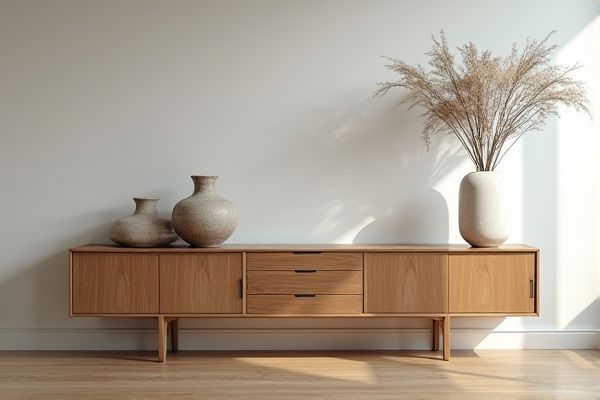
Painted consoles offer a sleek, modern aesthetic with customizable colors to suit your decor, while natural wood consoles showcase authentic grain patterns and timeless warmth. Explore the rest of the article to discover which console style best complements your space and lifestyle.
Table of Comparison
| Feature | Painted Console | Natural Wood Console |
|---|---|---|
| Appearance | Uniform color, smooth finish | Visible wood grain, natural texture |
| Durability | Resistant to stains; paint may chip over time | Strong, can scratch or dent |
| Maintenance | Easy to clean; repaint if needed | Requires polishing; sensitive to moisture |
| Cost | Generally affordable | Often higher due to quality wood |
| Customization | Wide range of colors and finishes | Limited to natural wood tones |
| Environmental Impact | May involve synthetic chemicals | Biodegradable; sourced sustainably |
Introduction: Painted Console vs Natural Wood Console
Painted consoles offer vibrant colors and modern finishes that can easily match contemporary decor, while natural wood consoles highlight authentic grain patterns and timeless warmth. Choosing between the two depends on your style preference and maintenance expectations, as painted surfaces may require touch-ups while natural wood benefits from periodic sealing. Your decision influences the overall ambiance and character of your living space, making it essential to weigh durability, aesthetics, and personal taste.
Aesthetic Appeal: Colors and Finishes
Painted consoles offer a vibrant range of colors and finishes that can complement contemporary and eclectic interiors, allowing you to customize your space with bold or subtle tones. Natural wood consoles emphasize the organic beauty of wood grain and texture, providing a timeless and warm aesthetic that ages gracefully over time. Your choice depends on whether you prefer the sleek, polished look of paint or the rich, authentic charm of natural wood surfaces.
Durability and Maintenance Comparison
Painted consoles offer enhanced resistance to moisture and stains due to their protective finish, making them easier to clean and maintain over time. Natural wood consoles, while offering unique grain patterns and aesthetic appeal, require regular treatment with oils or varnishes to prevent drying, cracking, and damage from environmental factors. In terms of durability, painted surfaces guard against scratches and fading better, whereas natural wood may develop patina but demands more upkeep to retain its structural integrity.
Customization Options and Flexibility
Painted consoles offer extensive customization options with a wide array of colors and finishes, allowing you to perfectly match your existing decor or create a bold statement piece. Natural wood consoles showcase the unique grain patterns and textures inherent to each type of wood, providing a timeless, organic aesthetic that evolves with age. Choosing between these options depends on your preference for versatile design adaptability or the authentic beauty of natural materials.
Environmental Impact: Paint vs Natural Finishes
Natural wood consoles with untreated or minimally finished surfaces typically have a lower environmental footprint due to their reduced use of chemicals and solvents, promoting better indoor air quality and easier recyclability. Painted consoles often involve synthetic coatings containing volatile organic compounds (VOCs) and other hazardous chemicals, which contribute to air pollution and require energy-intensive manufacturing processes. Choosing natural finishes derived from plant-based oils or waxes can further mitigate environmental impact by offering biodegradable and non-toxic alternatives to traditional paint.
Cost Differences: Budget Considerations
Painted consoles typically cost less than natural wood consoles due to lower material expenses and simpler manufacturing processes, making them a budget-friendly option for affordable home decor. Natural wood consoles, crafted from solid hardwoods like oak or walnut, command higher prices owing to the quality, durability, and intricate craftsmanship involved. Consumers balancing cost and aesthetics often opt for painted consoles to achieve a stylish look without the premium investment required for natural wood furniture.
Style Versatility: Matching Various Interiors
Painted consoles offer exceptional style versatility, easily blending with modern, minimalist, or eclectic interiors due to their wide range of colors and finishes. Natural wood consoles provide timeless warmth and rich textures that complement traditional, rustic, or Scandinavian designs effortlessly. Your choice depends on whether you want the adaptability of painted surfaces or the enduring organic appeal of natural wood grain.
Longevity and Aging: How Each Material Evolves
Painted consoles often exhibit greater resistance to scratches and stains, maintaining a consistent color over time, though paint may chip or fade with prolonged exposure to sunlight or moisture. Natural wood consoles develop a rich patina, showcasing unique grain patterns and warm tones that enhance their aesthetic appeal as they age, but they can be more susceptible to dents, warping, or fading if not properly maintained. Both materials require specific care: painted surfaces benefit from gentle cleaning to prevent chipping, while natural wood needs regular conditioning to preserve structural integrity and visual warmth.
Resale Value and Market Trends
Natural wood consoles generally hold higher resale value due to their timeless appeal and durability, attracting buyers who prioritize authenticity and quality. Painted consoles appeal to trend-conscious consumers seeking customizable and modern aesthetics but may experience depreciation as color trends shift. Market trends indicate a steady demand for natural wood furniture in the luxury segment, while painted consoles fluctuate more with interior design fads.
Choosing the Right Console for Your Space
Selecting the right console depends on your room's style and functional needs; painted consoles offer vibrant colors and sleek finishes that complement modern or eclectic interiors, while natural wood consoles provide warm, timeless appeal with unique grain patterns perfect for rustic or traditional settings. Consider durability and maintenance, as painted surfaces may require touch-ups over time, whereas natural wood might need regular polishing but ages gracefully. Assess the existing decor and lighting to ensure the console enhances the overall ambiance without overwhelming the space.
 homyna.com
homyna.com